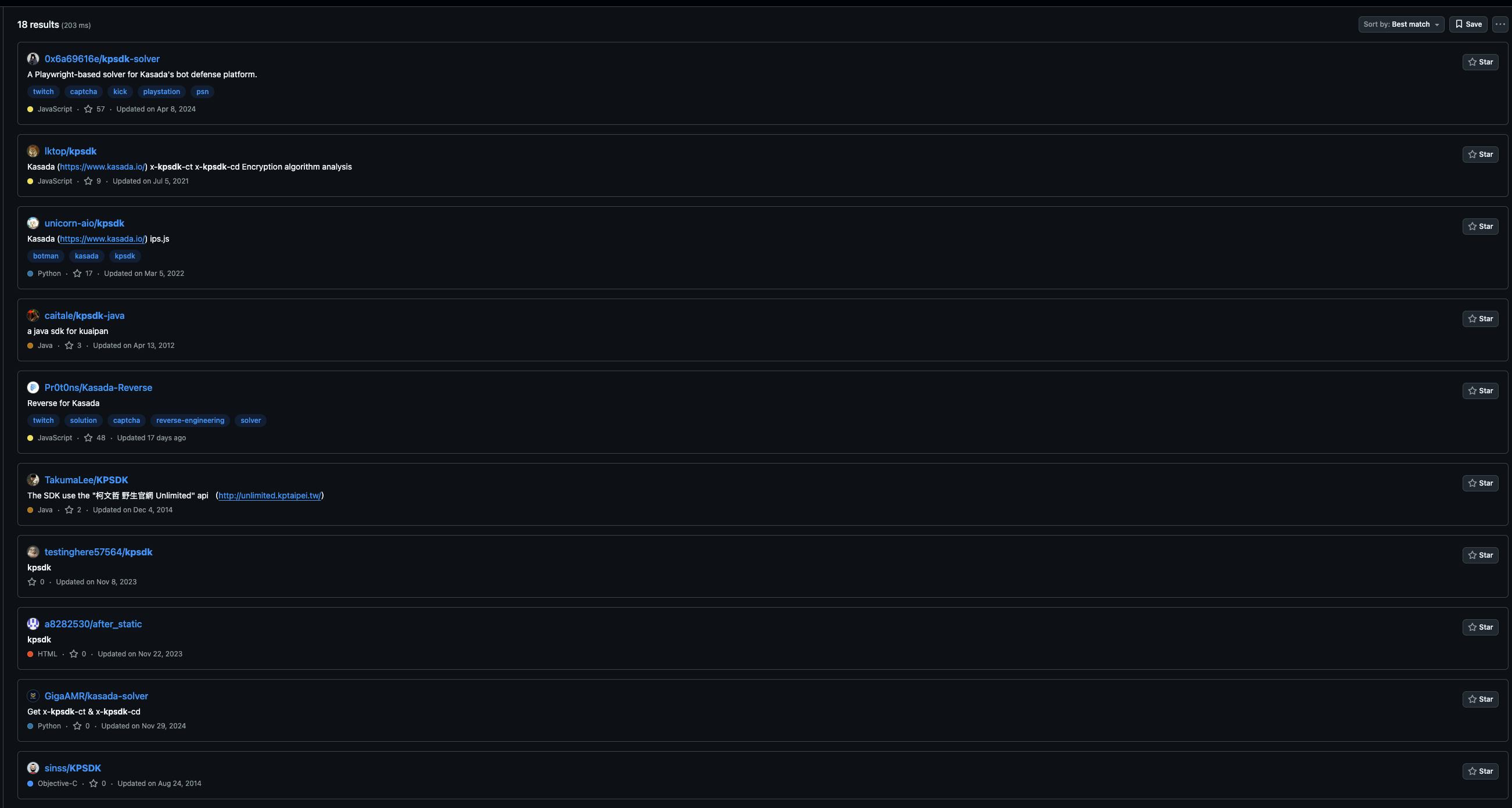Bypassing anti-bots is one of the major pain points a professional web scraper faces during their career. Luckily enough, the market offers several solutions for bypassing them, but delegating the heavy-duty work always comes with a price tag attached, which is not for every pocket.
As the saying goes, ‘If you want something done right, do it yourself.‘ So, let’s continue the series of articles about bypassing well-known anti-bot protections with Open-Source tools.
So, let’s see which open-source tools we can use to bypass the Kasada anti-bot in 2025, keeping some dollars in our pockets.
As always, we need to choose a website on which to test our solutions. Today, it’s Canada Goose, the e-commerce site of the famous outerwear brand.
The easiest way to detect when a website is using Kasada is by asking it for
As a double check, since the Wappalyzer data can be stale, you can visit the website with the network tab of the Developers Tools open (but first, tick the “preserve log” box).
If you notice that the website first returns a 429 error and then loads correctly, this is the typical behavior of a Kasada-protected website.
This is also confirmed by the presence of this access control header on the following calls: x-kpsdk-ct,x-kpsdk-r, and x-kpsdk-c and x-kpsdk-ct token.
So, calculating the token is enough?
I often hear this from people trying to bypass an anti-bot solution: We need to generate a valid token to get clearance to scrape the website’s data.
While it could be interesting to learn to reverse engineer a commercial solution like Kasada, this is not the best approach if you need data soon. It takes time, and you must restart after every change in the anti-bot software. Despite the difficulties,
My preferred approach, instead, is to create a human-like request that mixes with the actual website traffic and goes unnoticed by the crowd.
Of course, this approach is slower since it requires a browser automation tool, but it’s also more ethical than bombarding the target server with hundreds of requests per second.
In this article, we’ll see three different open-source tools that allow you to bypass Kasada using Playwright and a modified browser.
Standard Playwright ❌
Before trying more undetected tools, let’s start with a simple script using a standard version of Playwright and Brave Browser.
from playwright.sync_api import sync_playwright
import time
CHROMIUM_ARGS= [
'--no-sandbox',
'--disable-setuid-sandbox',
'--no-first-run',
'--disable-blink-features=AutomationControlled',
'--start-maximized'
]
with sync_playwright() as p:
browser = p.chromium.launch_persistent_context(user_data_dir='./userdata/',channel='chrome',no_viewport=True,executable_path='/Applications/Brave Browser.app/Contents/MacOS/Brave Browser', headless=False,slow_mo=200, args=CHROMIUM_ARGS,ignore_default_args=["--enable-automation"])
all_pages = browser.pages
page = all_pages[0]
page.goto('https://www.canadagoose.com/', timeout=0)
time.sleep(10)
page.goto('https://www.canadagoose.com/it/it/shop/donna/capispalla/giacche-imbottite/shop-womens-puffers', timeout=0)
time.sleep(10)
browser.close()
I often use Brave in these examples because it’s a browser that adds some noise to the WebGL fingerprint, even though it’s not as powerful as a real anti-detect browser.
The test miserably fails, as we get a blank screen for both URLs, another distinguishing mark of Kasada.
Patchright ✅
A stealthier version of Playwright is
The best part of the game?
You just need to change the imported package; the scraper is the same as the Playwright one. I just added the proxies and used the default browser installed with the library.
from patchright.sync_api import sync_playwright
import time
import os
proxies = {
'server': 'http://ENDPOINT:PORT',
'username': 'USER',
'password': 'PWD'
}
CHROMIUM_ARGS= [
'--no-first-run',
'--disable-blink-features=AutomationControlled',
'--force-webrtc-ip-handling-policy'
]
with sync_playwright() as p:
browser = p.chromium.launch(headless=False,slow_mo=200, args=CHROMIUM_ARGS,ignore_default_args=["--enable-automation"])
context = browser.new_context(proxy=proxies, ignore_https_errors=True, permissions=['geolocation'])
page = context.new_page()
page.goto('https://www.canadagoose.com/', timeout=0)
time.sleep(10)
page.goto('https://www.canadagoose.com/it/it/shop/donna/capispalla/giacche-imbottite/shop-womens-puffers', timeout=0)
time.sleep(10)
HTML_text = page.content()
print(HTML_text)
browser.close()
Now, the scraper works like a charm.
Zendriver ✅
Another package I tested is
I chose it instead of Nodriver because it is updated more often, and I was curious to test it.
It uses the Chrome Developer Protocol to interact with the browser, rather than a webdriver, and Python Async API to speed up the crawling.
import asyncio
import zendriver as zd
import time
proxies = {
'server': 'http://ENDPOINT:PORT',
'username': 'USER',
'password': 'PWD'
}
async def main():
async with await zd.start(browser_executable_path='/Applications/Brave Browser.app/Contents/MacOS/Brave Browser', proxy=proxies) as browser:
await browser.get('https://www.canadagoose.com/')
time.sleep(10)
await browser.get('https://www.canadagoose.com/it/it/shop/donna/capispalla/giacche-imbottite/shop-womens-puffers')
time.sleep(10)
await browser.stop()
if __name__ == "__main__":
asyncio.run(main())
The small script can bypass Kasada and show us the pages without requiring us to set any particular options. Great discovery!
Camoufox ✅
Last but not least, one of the most mentioned libraries on these pages is
It’s an open-source anti-detect browser run by Playwright. It adds important features, such as human-like mouse movement and the ability to forge real fingerprints.
In this case, we just forged a new fingerprint of a Windows machine but didn’t move the mouse around the page, but that was enough to load the requested pages correctly.
from camoufox.sync_api import Camoufox
import time
import os
proxies = {
'server': 'http://ENDPOINT:PORT',
'username': 'USER',
'password': 'PWD'
}
with Camoufox(humanize=True,os="windows", geoip=True, proxy=proxies) as browser:
page = browser.new_page()
page.goto('https://www.canadagoose.com/', timeout=0)
time.sleep(5)
page.goto('https://www.canadagoose.com/it/it/shop/donna/capispalla/giacche-imbottite/shop-womens-puffers', timeout=0)
time.sleep(5)
HTML_text = page.content()
print(HTML_text)
browser.close()
The open-source community is always amazing and creates such great tools that sometimes don’t get the right appreciation.
Camoufox is a great example of a product that is on the same level as a commercial one.
What’s the best open-source tool you use for scraping? Please write it in the comment section!













